Today we have our review of the Dell EMC 4GMN7 or Broadcom 57404. Broadcom makes this 25GbE NIC for Dell EMC servers. That includes enhancements such as integration for iDRAC. At the same time, they function as standard PCIe devices. 25GbE networking is a major trend in the 2020’s so we are focusing more on that ecosystem. You may have seen the recent Ubiquiti UniFi USW-Leaf Switch Overview with 48x 25GbE and 6x 100GbE ports or our Supermicro AOC-S25G-i2S adapter review. This is going to continue that series.
Dell EMC 4GMN7 / Broadcom 57404 Overview
The card itself is a passively cooled unit with two SFP28 ports. SFP28 is an evolution of the 10GbE era SFP+ ports that are used for 25GbE. We found these cards are backward compatible with 10GbE SFP+ networking as well.
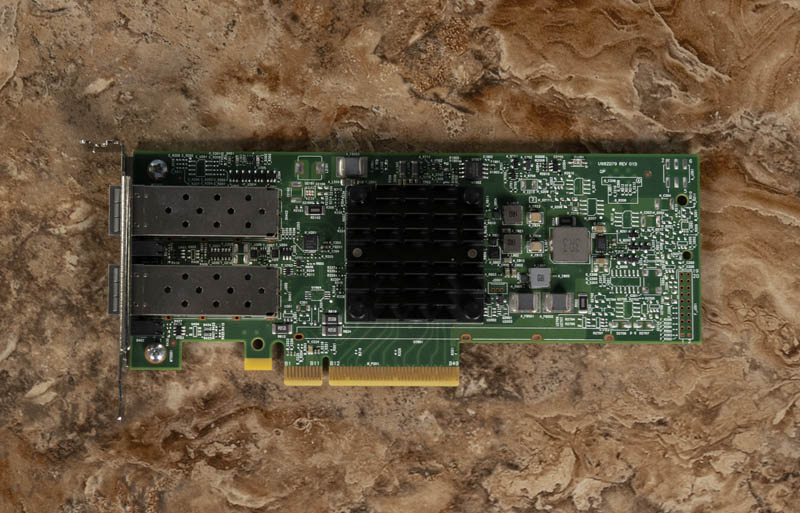
The overall card itself if a low-profile PCIe 3.0 x8 device. It is designed to accommodate low-profile slots but one can use a full-height bracket as well.
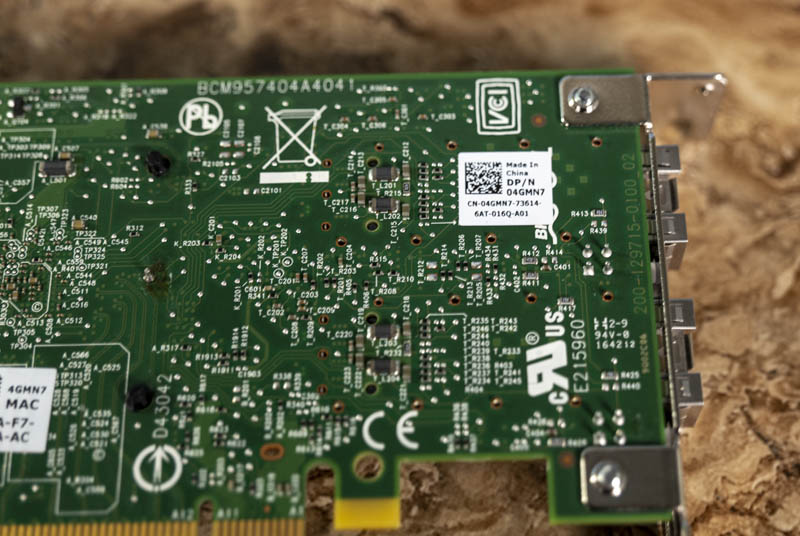
The back of the card contains a variety of stickers showing the Dell EMC and Broadcom (BCM) part numbers. This is part of the Broadcom NetXtreme E-series of network adapters.
Dell EMC 4GMN7 / Broadcom 57404 Key Specs
Instead of re-inventing the wheel, here are the key features and specs for the card from Dell and Broadcom:
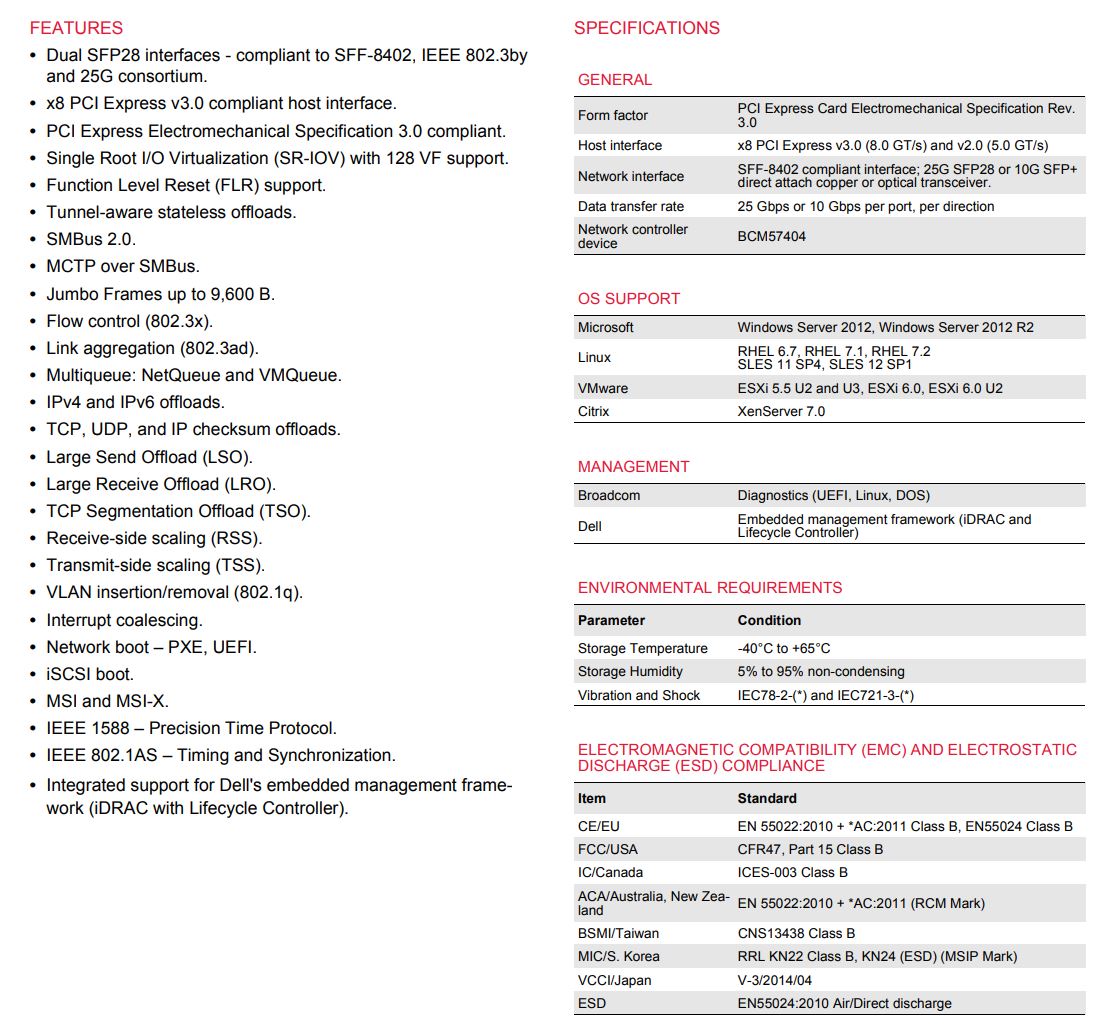
As you can see, these particular cards have optimizations to work with Dell’s iDRAC. At the same time, we have tried them in Inspur, Supermicro, Gigabyte, and Tyan Xeon Scalable-based servers and they worked like normal NICs. You are also going to notice the conspicuous absence of iWARP and RoCE acceleration that one finds on newer NICs. These are older cards, so we see them more as a value play. Otherwise, something like the Mellanox ConnectX-4 Lx will make more sense.
Dell EMC 4GMN7 / Broadcom 57404 in Linux
We wanted to take a few moments to show our readers what these NICs look like installed. Here is a look at the lshw output:
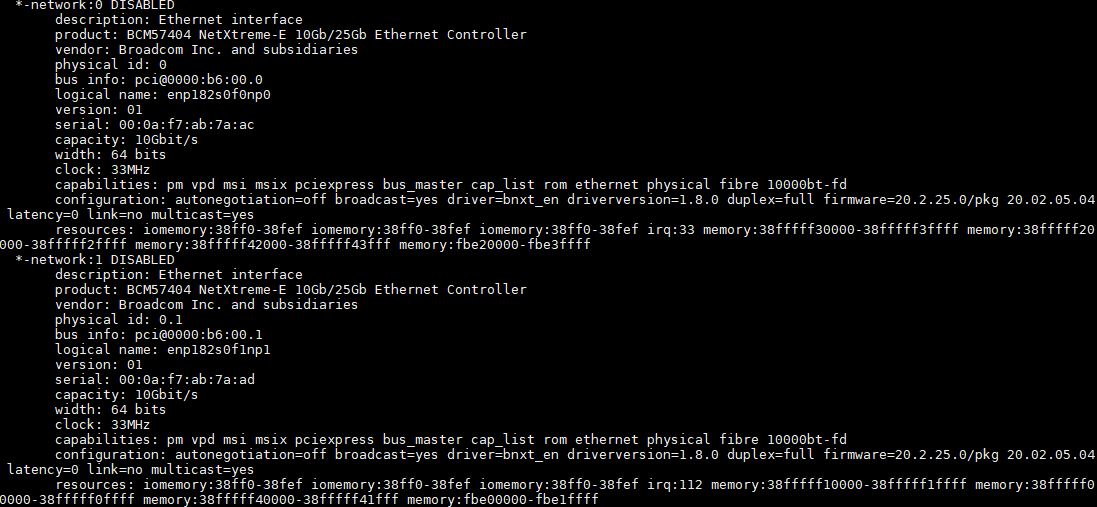
Here is the NIC in ethtool:
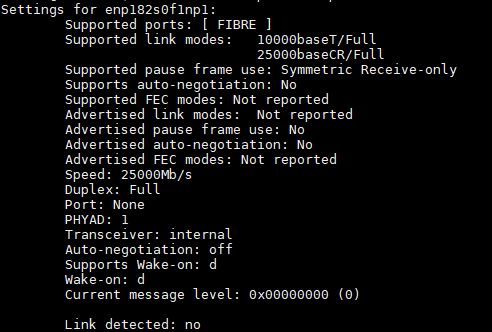
Here is the lspci -vvv output for the NIC:
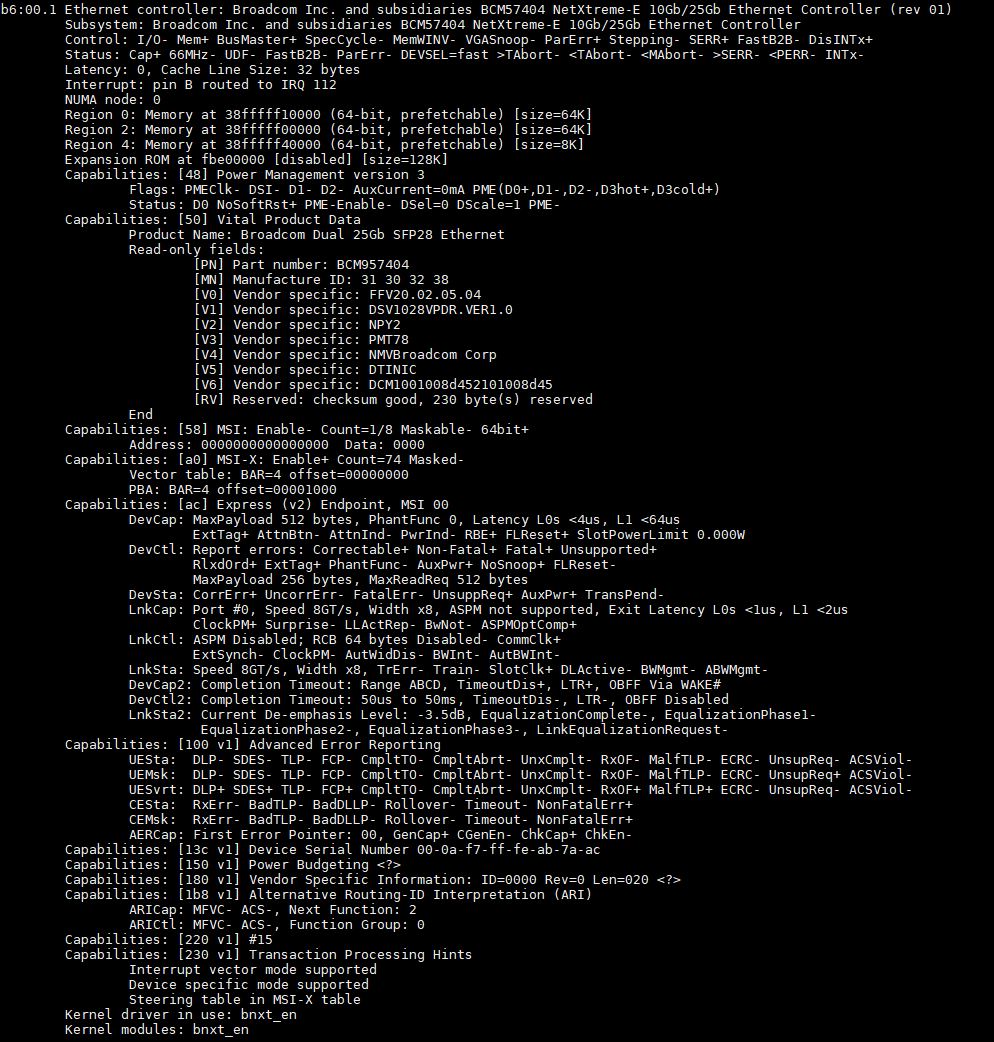
When we had taken these screenshots we apparently took them off the disconnected port. That is a point of improvement for the next review.
Dell EMC 4GMN7 / Broadcom 57404 Performance
We tested the Dell EMC 4GMN7 / Broadcom 57404 using a 1m breakout SFP28 DAC to our 32-port 100GbE Dell Z9100-ON data center switch. We then varied the port speed and connection type to our network storage.
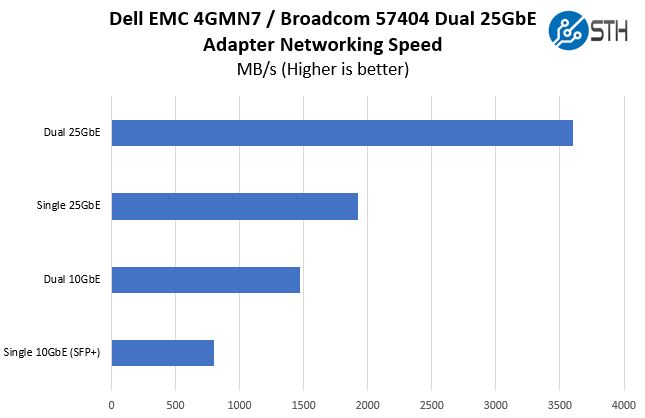
Overall, these are solid results that are in-line with what we saw from the Intel solution, albeit slightly slower. Given the aging feature set, we would suggest that one does not look as these NICs for the absolute highest performance.
Final Words
At this point, it the Dell EMC 4GMN7 and Broadcom 57404 is a solid option for Dell EMC servers so long as the price is right and the application does not call for acceleration that these NICs cannot provide. The pockets where these NICs are popular should be seeing them at reasonable pricing. On the other hand, if workloads and offload needs change, it may be better to look at updated 25GbE adapters.

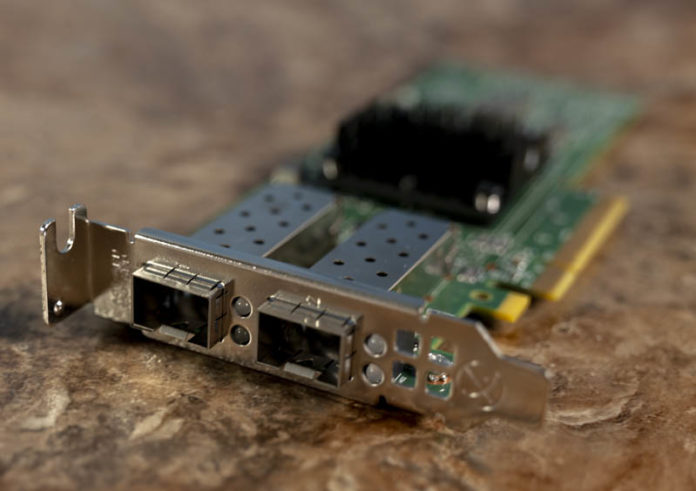



You’ll have to pardon my ignorance on this but can these be used with 10GBE adaptors to switch them to copper so that for instance, one port can be directly connected from a NAS to a workstation and the other port used with an adapter connected to a 10G switch for 25G between those two devices and 10G to the rest of the network?
P.S. the audio on your videos is SUBSTANTIALY better, thank you for listening to your community!
I believe this NIC has been superceded by the Broadcom 57414, which is the only option for new Dell servers as both PCIe adapter, as NDC, as OCP 2.0 card (R6515/R7515) and likely OCP 3.0 (R7525). The new 57414 card supports RoCE.
Thanks for the review!
Please add some benchmark (or same benchmark with alternative configuration) that shows the difference with hardware supporting RDMa, iWARP and RoCE acceleration. No one does that and this would bring your networking reviews to another level.
Low latency is the name of the game for many applications and only having a simple throughput test doesn’t provide half the picture. A common example would be a pair of replicated database servers running in synchronized mode. Latency will rule how many transactions per second that can be pushed through an OLTP application. Advanced NICs are said to have sub microsecond latency port to port between two NICs. I haven’t seen anyone testing this.
I second Hans Hagberg’s plea.
Link to a paid report for about $200 or less, and you will need to get a CDN to take the load.
PDF files are easy to restrict access and printing and I think screen printing also. But given your target audience is not only engineering but consulting and engineering board members, I seriously suggest you publish your files using Microsoft content protection and email delivery to your customer inbox will guarantee your protection against copyright thefts. You have opportunity to explode the research reports market if you can publish segment metrics for eg this level of adapter against normalised synthetic benchmarks of accelerated adapters (so making a further, discounted for repeat purchases, payment necessary to read product by product results for the accelerated adapters you compare with non accelerated adapters ) if you can price the full survey at or below $1000. That’s a no brainier purchase for absolutely everyone we can think of.
Incidentally, my business used to be negotiating with advertising sponsors for publishing expanded tests and reporting like this, for free circulation to corporate customers. Fifty thousand circulation was the spot where the market bit hard enough for a pleasant party as the issue went “off plate”. (Off plate is literally just the pages coming hot and inked into the cutters and finishers, which point we are handed over to the USPS in commercial reality the mailman is the only further real step before readers react. Set up dedicated international freephone lines with smart human handling and relationships ensue. Sadly big advertising agencies have taken aggressive destructive actions by policy to deep six such endeavour. But we will consider a boutique deal if we can get together with a major OEM ad buyer who has a strong storyline to unveil across more than one season. I would vote for the relationship over the accounts any day that we don’t lose the ship in so doing.
Agreeing Adam,
We’re running a little bit more complicated than this, but we evaluated almost every serious audio setup for reportage, and this made our cut for our next acquisitions:
Sennheiser AVX-ME2-3 Digital Wireless Lavalier Microphone Set
We’re currently using a far less elegant solution so that we can evaluate solutions for more complicated filming. I’m sorry I have rather spammed you with my enthusiasm for your coverage today, but I sincerely regard your journalism as first rate and deserving of full professional production. Level up now and I genuinely believe that you could recreate the media market we lost so long ago that my company was founded in partial response to the catastrophic loss of trade press during the first internet boom.
I didn’t remember that you will need a XLR adapter for your camera if you’re running a S1.
But that’s still a professional turnkey broadcast audio setup for under a kilo buck, assuming you ask your dealer for the discount they’re not going to refuse you if you speak with Panasonic and explain your situation. Dealers have budgets from the manufacturers precisely for enticing clients of your calibre. Use this to the fullest. Leaving incentives on the table is doing capitalism wrong but I’m teaching my grandmother :-)
Sennheiser is great audio out of the box. I remember the first call I placed with their DW1-Pro DECT headset over Skype to a old friend in the classical music world. He couldn’t concentrate on our usual chat, so taken was he with the audio quality. This speaks for Microsoft and Dolby laboratories as well on the software link. We figured that combo, under five hundred dollars, beat the ISDN links we used to use that cost twenty times as much. The not turnkey setup we’re testing so we can handle conferences and audience participation in closed set demos and special focus sessions, is order of magnitude more costly and maybe two decimals more once designs planning and operations are included. This amortizes quickly including operator time and only setup and tear down time remains a constant. But we’re aiming for full broadcast delivery to network channels directly. Pass on what Sennheiser can do only after careful consideration please: you can do little better.
My apologies if you’re already setup and satisfied but this is a serious facility if you have nothing equivalent already. Remember that dealers will buy in competing equipment to no financial loss to you if you speak with them about your business.